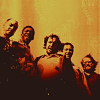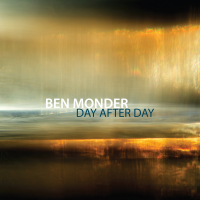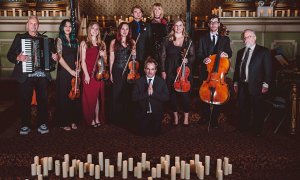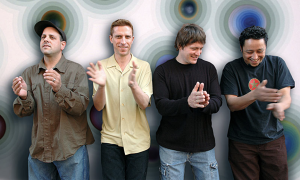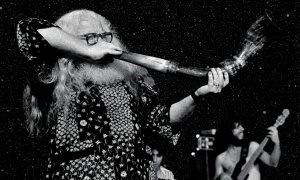Home » Jazz Articles » From the Inside Out » Put It Where You Want It (But Find It Where You Put It)
Put It Where You Want It (But Find It Where You Put It)
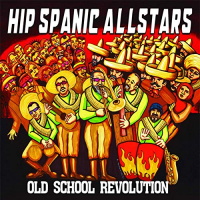 Hip Spanic All-Stars
Hip Spanic All-StarsOld-School Revolution
Self-Produced
2018
If you think that Old School Revolution sounds both familiar and new, you're right.
In the late 2000s, bassist and singer Happy Sanchez, saxophonist Norbert Stachel (Tower of Power), percussionist Karl Perazzo (a longstanding member of Santana), and drummer Jay Lane (Primus) hooked up, during timeouts from their more regular gigs, in the Mission District surrounding San Francisco with vocalists Shorty Ramos and Vic Castro, and the Hip Spanic All-Stars were born.
"We grew up in the era of the big funk groups, and they all had horns," Sanchez recalls. "A lot of those guys are not Latino but it really resonated with the community. That was where we drew our roots." (Perazzo and Sanchez have also contributed, through their Latin Soul Syndicate collaborative, music to The Sopranos, The Devil Wears Prada and many other shows and films.)
At its heart, Old-School Revolution is a Latin groove record. "Salsero" vaults from the starting blocks into the lively tale of a young man born to play salsa drums, backed up with "Party In The Mission," an abundant overflow of energy and spirit that screams out "The party's over HERE!" "Shake It" tops its guitar hook with a new wave, funk-punk edge, but gets quickly blown out of the water by the ensemble horns' typhoon of joyous Latin dance.
Even so, the diverse backgrounds of all these participants can't help but turn up additional party sounds; these include Cajun zydeco ("Welcome Back"), reggae ("Bacuna Wow Wow Wow"), and several vocal tunes with sweet harmonies and warm, soft textures, including a chunky and funky bop through "Crystal Blue Persuasion" and a shimmering Afro-Cuban-jazz-blues-funk reverie about cruising through the neighborhood "In My '64" classic ride.
"We're bringing back the old sound of harmonizing together, of drums and horns and Chicano grooves and funk," Sanchez happily concludes. "That's the old school revolution. It's an authentic, true sound from the US. These grooves make America great again."
 Molly Tigre
Molly TigreMolly Tigre
Very Special Recordings
2018
Personally, I can't resist a musical story that begins: "Molly Tigre set out from Brooklyn to answer one tough question: What if the 70s vibes of the cult Ethiopiques series collided with Saharan desert rock and West African blues, but with no guitar to lead the melodic way?" I'm not quite sure what some of that even means. But I do know that it intrigues me enough to find out.
"I wanted to bring together some of the music and styles from Northern Mali and certain regions in Ethiopia, like Tigray," co-founder and bassist Ezra Gale says to introduce and explain Molly Tigre's eponymous debut. "We both realized we were big fans of that music, and not many musicians were doing anything with that at the time," concurs saxophonist Mitch Marcus, also a member of the Afro-pop band Aphrodesia.
To flesh out and bring life to their shared vision, Gale and Marcus enlisted reedman Chris Hiatt from Japonize Elephants; percussionist Ibrahima Kolipe Camara from the National Dance Company of Guinea, Kakande; and drummer Joey Abba from The New York Jazz Exchange.
Untethered to any chord instrument other than Gale's monster-stomping bass and Marcus' occasional Farfisi organ, horns and percussion swim wild, deep and free through every level of Molly Tigre, painting in colorful and multicultural sounds. "Lebanese Blond" sets up two melodies and then turns them against each other, with saxophonists Marcus and Chris Hiatt blasting out improvisations from where they meet in the middle, recorded in a vibrant "live in the studio" sound that follows their interplay with such detail that you can feel them breathe in and out with each other.
"Couscous Timbuktu" lands in your ear like marching elephants, drums and percussion pounding the basic rhythm into a dirt path while bassist Gale keeps fat and heavy time like a metronome Buddha. Gale opens "Y Knot" with a resounding Charles Mingus-sounding bass prophecy before drums and percussion kick off a Latin jam with a twist of Middle Eastern flavor from the saxophone's overtones of John Coltrane and Pharoah Sanders.
"Ethiofreaks" incorporates vibes, a perfect addition to this simmering stew because it's both melodic and percussive, to honor Ethiopian jazz vibes master Mulatu Astatke; "Yekermo Sew," composed by Astatke, dances Molly Tigre directly back into Africa to close.
"There's a tradition of this in jazz, as people have done piano-less quartets," Gale concludes. "You get to imply harmonies without a guitar or piano spelling it out, which makes it open and free. It's hard to do well and make it sound full."
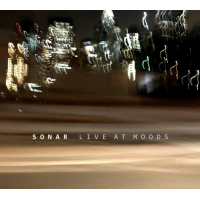 Sonar
SonarLive at Moods
7d Media
2018
Recorded Live at Moods jazz club in Zürich (Switzerland) in May 2018, this set reconnects guitar electronics visionary David Torn with the band Sonar. Torn played with Sonar on their previous album Vortex, and this live set picks up three tunes ("Waves and Particles," "Red Shift" and "Lookface!") from that earlier collaboration.
How does Sonar make their music sound so different? For starters, founding guitarist Stephan Thelen and Bernhard Wagner play guitars, and Christian Kuntner plays bass, in Thalen's unique "tritone" tuning. "I created a new tuning in which the guitar is tuned to tritones: C-F#, C-F#, C-F#," he explained in a 2014 interview. "We tried it out and never looked back. We all loved the natural harmonics of the tuning, and decided to go one step further and play as much as possible only using these harmonics. That led us to a whole new harmonic system that we call 'tritone harmonics.'"
Second, Sonar employs instrumentation most associated with progressive rock but focused almost exclusively on the progressive and leaving almost all the heavy, hard rock behind—They use familiar sounds but often in unfamiliar ways.
Propelled by whirling, circular time from drummer Manuel Pasquinelli, Sonar's singular approach results in a most unique sound on Live at Moods. "Twofold Covering" is the perfect opening and introduction: Based on a bass line that is exactly the same as the main guitar riff but played two octaves lower and half as fast, it meticulously builds up note by note, beat by beat, into a construction that seems to put itself together, take itself apart, and then put itself back together again. At its climax, guitar riffs pinwheel like musical skyrockets in colors fiery and fierce before melting into an electronic hurricane roar that blows the music away like dust.
"Waves and Particles" more effectively transitions from repetitive to hypnotic. It curiously feels like the music is rising up from the ground and bearing you up along with it, and similarly ends after electric guitar squalls pass through to rinse new colors into the sound.
Torn's improvised solo piece "For Lost Sailors" weaves rhythm and melody and harmony into a sound cloud that hovers and floats on feedback and loops, each note fluttering in the reflected sound of the notes that came before and after, even refracting the blues into that so cool it's frozen sound of Norwegian composer and guitarist Terje Rypdal.
Torn then sits out of "Tromsø," the very first piece of music that Sonar began rehearsing together and the first track on their first album (A Flaw of Nature [2012, Ronin Rhythm]). This piece suggests an electronic, digitalized Oregon, nuanced and subtle musical intercourse played primarily on instruments (bass, drum, guitars) not usually associated with such nuance and subtlety.
Live at Moods' sort of sneaks up on you but then disappears on you at the same time.
 Chris Trinidad
Chris TrinidadChris Trinidad's Chant Triptych II
Iridium Records
2018
Chris Trinidad seems unique even by musicians' standards: He keeps busy as a multi-instrumentalist, composer, choral conductor, and music educator in and around the San Francisco Bay area, but also has a background in liturgy, liturgical worship and educational leadership.
Chant Triptych II is the second in a series through which he reimagines traditional Gregorian chant melodies in new contexts created by arrangements of instruments from radically different cultures. Trinidad's instrumental palette features his own electric bass guitar; Indian tabla; acoustic and electric guitars; tambura, a stringed lute used in Balkan folk music and as a harmonizing drone in Indian music; bansuri, an Indian flute; and kanjira, a south Indian frame drum. "These melodies were originally used for sung liturgical prayer music, but I wanted to take them elsewhere," Trinidad explains.
Descriptive play-by-play rarely (and barely) does justice to the pure imagination in Trinidad's arrangements, which open up music deeply connected to a specific place (Central and Eastern Europe) and time (ninth and tenth centuries A.D.) for contemporary global jazz audiences. The opening "Sinite Parvulos" sounds more like an Indian raga (from its instrumentation) than a Gregorian chant, but then you can hear its somber original melody quietly assemble and then move forward together, led by tabla (Neelamjit Dhillon) and guitar (Alex Hand Miller) solos expertly played across cultural dividing lines. "I called on them to reach beyond their own borders, find common ground, and apply their 'many voices' in an unfamiliar musical context," suggests Trinidad.
Solo flute sounds the opening call of "Venite Filji," an uncomplicated call to worship; part two assembles the other instruments in a same glorious music posture, which feels quite liturgical and less like jazz even though there are obvious passages of improvisation—a beautiful creation reflected in truly beautiful sound. Arranging its melody onto a lute helps "Qui Timent" sound more Japanese than Gregorian, until Trinidad's electric bass cranks up its walking stride into a trot, and frees the accordion (Colin Hogan) and guitar soloists to color outside traditional lines with their improvisations.
"Nolite Diligere" distills all this technique and spirit in a three-minutes machine gun burst of celebratory and tribal musical joy, illuminated like holiday streetlights by Mario Salomon's bright and bouncy percussion.
 Various Artists
Various ArtistsNicola Conte Presents Cosmic Forest: The Spiritual Sounds of MPS
MPS Records
2018
A labor of love, Cosmic Forest was compiled by Italian musician, producer and DJ Nicola Conte to both revisit and present to a new audience Conte's favorite "spiritual jazz" recordings from MPS Records' 1965—'75 catalog. Eight of these thirteen pieces came from albums released as part of the MPS label's mid-1970s "Jazz Meets the World" series masterminded by jazz activist and label partner Joachim-Ernst Berendt.
Cosmic Forest can take you as deeply in or as far as you wish to go. Take a sunny stroll through "A Day in Vienna," for example, through its all-star date with saxophonist Dexter Gordon and trombonist Slide Hampton joining trumpeter Dizzy Reece in front of the intense rhythmic force of Kenny Drew (piano), Art Taylor (drums) and Niels Pederson (bass).
The Albert Mangelsdorff Quartet's "Never Let It End" consolidates melodies that trombonist Mangelsdorff picked up while touring throughout India, Japan, Thailand, and Vietnam, but on saxophone and trombone. The leader plays trombone with dexterity and dynamics associated more with trumpet players than trombonists, while his rhythm section sounds teleported into Germany from one of John Coltrane's spiritual Impulse! recordings with Pharoah Sanders.
George Gruntz'"Djerbi" features Eberhardt Weber, Sahib Shihab, and Jean-Luc Ponty among the sidemen for Swiss pianist Gruntz, plus a quartet of Bedouin musicians from North Africa, collectively exercising a traditional meditative dance from the island of Djerba that sounds more like a snakecharmer's hypnotic dance than a melody for meditation.
After that, Conte sets the controls of Cosmic Forest straight for the heart of the sun. A dense, vibrant live recording of "Timbales Calientes" by The MPS Rhythm Combination & Brass maintains a furious pace, with brass and woodwinds quickly jumping in and out of each other's riffs before the titular "hot timbales" jump into the fray. "Revelation" by Hannibal (American avant-garde trumpeter and composer Hannibal Marvin Peterson) and The Sunrise Orchestra emerges from the same deep rhythmic meeting place of Coltrane and Sanders and Africa and jazz, ripping with pulses and counter-rhythms while Peterson's trumpet majestically rises above the Orchestra's rhythm not softly but as a blazing morning sunrise.
"Burungkaka Tua," an Indonesian traditional from reedman Tony Scott's Jazz Meets the World album Djanger Bali with the Indonesian All-Stars, lingers in its moody piano introduction like a melancholy cloud; Scott sings its second half on flute, spiraling out a mystical Eastern sound that falls into your ears as genuinely as Yusef Lateef's seminal Eastern Sounds (Prestige, 1961).
A mashup of Eastern and Western music, composed and improvised, rendered in a unique instrumental sound, "Raga Jeeva Swara" by the Dave Pike Set with guitarist Volker Kriegel, ends your trip through this Cosmic Forest with a vision full of wonder and magic, twirling in the sitar's dervish dance and chiming like birdsong from the leader's vibes.
 Andrés Vial
Andrés VialPlays Thelonious Monk: Sphereology Volume One
Chromatic Audio
2018
Pianist Andrés Vial has been working on this Sphereology project since 2005, when he organized a Thelonious Monk music festival in his Montreal hometown. "My band played four nights of Monk's music there," he recalls. "I transcribed about fifty of his tunes for those gigs, and the festival ran for four years."
"Even though Monk is a hugely important part of the jazz canon, musicians usually only play about a dozen of his tunes. There are another sixty tunes that are very infrequently performed."
Vial builds Volume One entirely upon these "(an)other sixty tunes," scaling some of Monk's craggiest heights with grace, power, and a whole lot of rhythm. He's joined on his climb by guitarist Peter Bernstein, an expert interpreter of Monk's often curious muse-ic, and two different rhythm sections: New York City jazz linchpins Rodney Green (drums) and Dezron Douglas (bass), and the Montreal-based rhythm section of André White (drums) and Martin Heslop (bass).
"I consider Peter one of the leading interpreters of Monk's music today," Vial explains. "He's one of the rare people who, if we're on a gig together, I can call a bunch of practically esoteric Monk tunes and he'll know them."
Sphereology Volume One appropriately begins and ends in the blues, opening with "Bluehawk" (which Monk recorded only once, as a solo piece) and closing with an eight-minute bump-and-grind through "Functional."
Pianist and guitarist shape their introductory duet to "Ugly Beauty" around Monk's solo introduction to his original 1968 recording, then smooth out the lilting rhythm of the only waltz Monk composed into a blues tempo and tone, gloriously aglow with all the unresolved contradictions of Monk's music.
Vial and his ensembles deftly navigate through the curiously metered (18.5 bars) "Coming On The Hudson," the up-tempo toe-tapper "Green Chimneys" and the delightfully curious, childlike wonder of "Introspection." Vial and Bernstein duet for more than seven minutes on "Ask Me Now," which suggests Monk's romantic take on "My One and Only Love."
It sounds like such a small or even curious thing, but in Monk's music it's so important: On Sphereology Volume One, Vial profoundly demonstrates the importance of silence and space (structural, harmonic and melodic) in Monk's music. "Monk tunes are already perfect," Vial concludes. "It's impossible to separate the melody from the rhythmic concept and chord voicings in each composition."
Vial, Bernstein and the rhythm sections make what they do sound so easy (almost effortless), that you can sometimes lose appreciation for how amazing it is—painting a portrait of one of the most monumental composers in jazz, in the colorful brushstrokes of their own ideas. If there's a better way to honor Monk, help me "Think of One."
Tracks and Personnel:
Old-School Revolution
Tracks: Crystal Blue Persuasion; Salsero; Party In The Mission; In My 64; Shake It; Welcome Back; This World Is Made For Lovers; Bacuna Wow Wow Wow; All Aboard; Funky Cha Cha Cha; La Boa; Conga Radio.
Personnel: Happy Sanchez: vocals, bass; Victor Castro: vocals; Gordon Ramos: vocals; Norbert Stachel: baritone tenor & alto saxophones; Karl Perazzo: congos, timbales; Andrew Stern: guitar; Dave Shul: guitar; Jay Lane: drums; Frank Navarro: bass; Ruben Sandoval: trombone; Phil Adams: trumpet; Bob Crawford: piano, clavinet; Tony Stead: Hammond B3 organ, accordion; Kike Padilla: conga solo; Ricky Encarnacion: bass.
Molly Tigre
Tracks: Hello Bolly; Lebanese Blond; Couscous Timbuktu; Y Knot; Ethiofreaks; Slush Fund; Tolo; Yekermo Sew.
Personnel: Mitch Marcus: tenor sax, baritone sax, farfisa; Chris Hiatt: alto sax, tenor sax, flute; Ezra Gale: bass; Ibrahima Kolipe Camera: djembe, conga, percussion; Joe Abbatantuono: drums, cymbals; Seth Paris: alto sax; Mamadou Konate Simbo: djembe, talking drum; Tommy Mattioli: vibraphone.
Live at Moods
Tracks: Twofold Covering; Waves and Particles; Red Shift; Tromsø; For Lost Sailors; Lookface!.
Personnel: David Torn: electric guitar, live looping; Stephan Thelen: tritone guitar; Bernhard Wagner: tritone guitar; Christian Kuntner: tritone bass; Manuel Pasquinelli: drums.
Chant Triptych II
Tracks: Sinite Parvulos; Beatus Quem Elegisti; Dispersit Dedit Pauperibus; Venite Filii; Qui Timent; Nolite Diligere; Timeat Eum; Qui Fecerit.
Personnel: Chris Trinidad: bass guitar; Alex Hand Miller: guitar, tambura; Neelamjit Dhillon: tabla, bansuri, kanjira, alto saxophone; Mario Salomon: bongo, congas, campana, maracas; Colin Hogan: accordion, melodica .
Nicola Conte Presents Cosmic Forest: The Spiritual Sounds of MPS
Tracks: Maiden Voyage (The Third Wave); Evolution (Nathan Davis); A Day in Vienna (Dexter Gordon, Slide Hampton); Yaad (Motihar Trio, Irene Schweizer Trio, Manfred Schoof, Barney Wilen); Djerbi (George Gruntz); Never Let It End (Albert Mangelsdorff Quartet); Shelda (Smoke); Soledad de Murcia (Michael Naura Quartet); Timbales Calientes (The MPS Rhythm Combination & Brass); El Babaku (El Babaku); Revelation (Hannibal and The Sunrise Orchestra); Burungkaka Tua (Tony Scott & The Indonesian All-Stars); Raga Jeeva Swara (Dave Pike Set).
Personnel: The Third Wave (Maiden Voyage); Nathan Davis (Evolution); Dexter Gordon, Slide Hampton (A Day in Vienna); Motihar Trio, Irene Schweizer Trio, Manfred Schoof, Barney Wilen (Yaad); George Gruntz (Djerbi); Albert Mangelsdorff Quartet (Never Let It End); Smoke (Shelda); Michael Naura Quartet (Soledad de Murcia); The MPS Rhythm Combination & Brass (Timbales Calientes); El Babaku (El Babaku); Hannibal and The Sunrise Orchestra (Revelation); Tony Scott & The Indonesian All-Stars (Burungkaka Tua); Dave Pike Set (Raga Jeeva Swara).
Plays Thelonious Monk: Sphereology Volume One
Tracks: Bluehawk; Coming On The Hudson; Think Of One; Ugly Beauty; Green Chimneys; Light Blue; Ask Me Now; Introspection; Work; Functional.
Personnel: Andres Vial: piano; Peter Bernstein: guitar; Dezron Douglas: bass (1-6); Rodney Green: drums (1-6); Martin Heslop: bass (8-10); Andre White: drums (8-10).
Tags
About Molly Tigre
Instrument: Band / ensemble / orchestra
PREVIOUS / NEXT
Support All About Jazz
 All About Jazz has been a pillar of jazz since 1995, championing it as an art form and, more importantly, supporting the musicians who make it. Our enduring commitment has made "AAJ" one of the most culturally important websites of its kind, read by hundreds of thousands of fans, musicians and industry figures every month.
All About Jazz has been a pillar of jazz since 1995, championing it as an art form and, more importantly, supporting the musicians who make it. Our enduring commitment has made "AAJ" one of the most culturally important websites of its kind, read by hundreds of thousands of fans, musicians and industry figures every month.


